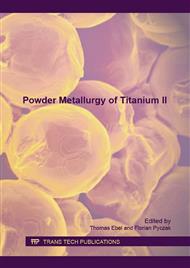p.118
p.122
p.130
p.139
p.148
p.155
p.161
p.173
p.183
Two-Component Metal Injection Moulding of Ti-6Al-4V and Stainless Steel Bi-Material Parts
Abstract:
Two-component metal injection moulding (2C-MIM) allows producing functionally graded metal parts of complex shape by co-sintering. Until now several studies have demonstrated that different material properties can be combined. Another promising material combination is titanium and iron-based materials. It can combine the biocompatibility and low density of titanium with a ductile and cost efficient stainless steel. However, co-sintering these materials reveals challenges due to a significant mismatch in sintering shrinkage and limitations in sintering temperature for both materials. The recent study showed that Ti-6Al-4V can be joined to the stainless steel 316L by 2C-MIM provided that certain constraints are taken in account. The quality of the interface before and after co-sintering is a crucial factor for intact parts after processing. By applying sinterdilatometry the mismatch in shrinkage was compensated by using adjusted powder characteristics and tailored feedstock compositions. A co-sintering cycle was defined with regard to the sintering characteristics of both materials. The developed two-component specimens revealed significant interdiffusion of alloying elements at the Ti-6Al-4V / 316L interface and a tensile strength of 282 MPa after co-sintering.
Info:
Periodical:
Pages:
148-154
Citation:
Online since:
August 2016
Authors:
Price:
Сopyright:
© 2016 Trans Tech Publications Ltd. All Rights Reserved
Share:
Citation:


